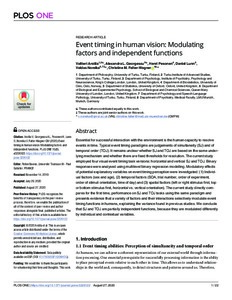Event timing in human vision: Modulating factors and independent functions
Valtteri Arstila; Alexandra Georgescu; Henri Pesonen; Daniel Lunn; Valdas Noreika; Christine Falter-Wagner
https://urn.fi/URN:NBN:fi-fe2021042826504
Tiivistelmä
Essential for successful interaction with the environment is the human
capacity to resolve events in time. Typical event timing paradigms are
judgements of simultaneity (SJ) and of temporal order (TOJ). It remains
unclear whether SJ and TOJ are based on the same underlying mechanism
and whether there are fixed thresholds for resolution. The current study
employed four visual event timing task versions: horizontal and
vertical SJ and TOJ. Binary responses were analysed using multilevel
binary regression modelling. Modulatory effects of potential explanatory
variables on event timing perception were investigated: (1) Individual
factors (sex and age), (2) temporal factors (SOA, trial number, order of
experiment, order of stimuli orientation, time of day) and (3) spatial
factors (left or right stimulus first, top or bottom stimulus first,
horizontal vs. vertical orientation). The current study directly
compares for the first time, performance on SJ and TOJ tasks using the
same paradigm and presents evidence that a variety of factors and their
interactions selectively modulate event timing functions in humans,
explaining the variance found in previous studies. We conclude that SJ
and TOJ are partially independent functions, because they are modulated
differently by individual and contextual variables.
Kokoelmat
- Rinnakkaistallenteet [27094]
